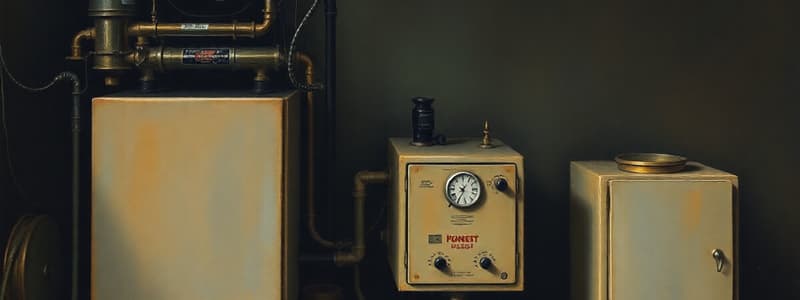Podcast
Questions and Answers
Explain the purpose of using dual chambers in D-790A/B (Air Driers) instead of a single chamber system?
Explain the purpose of using dual chambers in D-790A/B (Air Driers) instead of a single chamber system?
Dual chambers allow for continuous operation. While one chamber dries the air, the other undergoes regeneration, ensuring a constant supply of dry instrument air.
Why is F-790 (Prefilter) placed before the air driers (D-790A/B) in the instrument air system?
Why is F-790 (Prefilter) placed before the air driers (D-790A/B) in the instrument air system?
The prefilter removes particulates and coalesces water, protecting the desiccant in the air driers from fouling and extending its lifespan, which optimizes the drier's performance.
What is the purpose of the Dry Air Receiver (D-791) in the instrument air system, and how does it achieve this purpose?
What is the purpose of the Dry Air Receiver (D-791) in the instrument air system, and how does it achieve this purpose?
The Dry Air Receiver separates free water from the incoming plant air via gravity separation. Plant air enters the bottom, allowing water to settle, and dry air exits from the top.
If the automatic drain on F-790 (Prefilter) fails, what potential problems could arise in the downstream equipment?
If the automatic drain on F-790 (Prefilter) fails, what potential problems could arise in the downstream equipment?
Why is F-791 (After-filter) installed after the air driers (D-790A/B) and before the unit being serviced?
Why is F-791 (After-filter) installed after the air driers (D-790A/B) and before the unit being serviced?
Flashcards
D-791 (Dry Air Receiver)
D-791 (Dry Air Receiver)
Separates free water from incoming plant air, drained manually.
F-790 (Prefilter)
F-790 (Prefilter)
Removes particulates and coalesces entrained water from the air.
D-790A/B (Air Driers)
D-790A/B (Air Driers)
Removes water vapor using dual desiccant chambers; one dries, the other regenerates.
F-791 (After Filter)
F-791 (After Filter)
Signup and view all the flashcards
Back-up instrument air
Back-up instrument air
Signup and view all the flashcards
Study Notes
- Plant air from Unit 1092 goes to D-791 (Dry Air Receiver).
- Free water is separated in D-791 and manually drained.
- Air then goes to F-790 (Prefilter) to remove particulates and coalesce any remaining water.
- Accumulated water in F-790 is automatically drained.
- To eliminate remaining water vapor, air flows to the top of D-790A/B (Air Driers) and out the bottom.
- Air then passes through F-791 (After-filter) before being routed to the unit for service.
- Nitrogen is supplied as back-up instrument air if instrument air pressure is low.
Equipment Details
- D-791 (Dry Air Receiver), F-790 (Prefilter), D-790A/B (Air Driers), and F-791 (After Filter) are key pieces of equipment.
D-791 (Dry Air Receiver)
- D-791 measures 3’D x 8’L.
- D-791 separates any free water from incoming plant air.
- Plant air enters the bottom side of D-791.
- Water is manually drained from the bottom.
- Dry air exits from the top.
F-790 (Prefilter)
- F-790 removes contaminants from the instrument air.
D-790A/B (Air Driers)
- D-790A/B are absorptive desiccant dryer packages which remove water vapor from compressed air.
- Dual chambers allow for continuous service; one dries the wet inlet stream while the other regenerates.
- Plant air enters the top of D-790A/B.
- Dry instrument air exits the bottom.
F-791 (After Filter)
- F-791 removes contaminants from the instrument air.
Studying That Suits You
Use AI to generate personalized quizzes and flashcards to suit your learning preferences.


